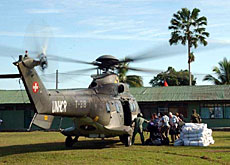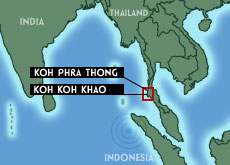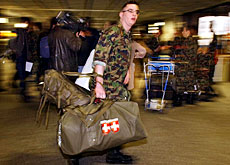Tsunami aid shifts gear

Exactly two months after a devastating tsunami hit southeast Asia, Switzerland is focusing its aid efforts on rebuilding infrastructure and restoring self-sufficiency.
The Swiss government has contributed SFr27 million ($23 million) to the tsunami relief effort, while private Swiss donors have given more than SFr200 million.
The Swiss Agency for Development and Cooperation (SDC) is concentrating its efforts on projects in the worst affected countries; Indonesia, Sri Lanka and Thailand.
Up to 250,000 people died in the disaster, and the number made homeless is estimated at 800,000.
Willy Lenherr, head of the SDC’s Asia Division, said two of the projects on the Indonesian island of Sumatra are focused on water – the restoration of the water supply in Banda Aceh and the cleaning of wells in Melabo on the west coast.
“We have already cleaned roughly 200 wells which is not easy because they get dirty from the salty water and things that were washed in, so one cleaning round is not enough,” Lenherr told swissinfo.
Vital importance
Lenherr says the water projects are of vital importance. Last week the UN said that fresh water supplies in tsunami-hit countries were under serious threat, with sources being hit by salt water, sewage and toxic waste.
Another project offers cash to families in Indonesia and Sri Lanka in return for providing shelter to people made homeless by the tsunami.
An expected 100,000 people could benefit from the scheme. It is still in its pilot phase, but Lenherr expects payments in Sri Lanka to start in the next two to three weeks.
“This is a very efficient and fast way of avoiding people going into camps and to put people in a more social and positive environment to help them overcome the trauma of the disaster,” said Lenherr.
Fishing villages
One of the most famous – and controversial – aid efforts is the rebuilding of three fishing villages on the islands of Koh Kho Khao and Koh Phra Thong in southern Thailand.
The idea came from Foreign Minister Micheline Calmy-Rey while on a visit to the area to assess the situation shortly after the tsunami.
“Afterwards people thought what Switzerland was going to do was build a Swiss village – it’s not like that,” said Lenherr.
“We have been helping the fishing community to start a new life and earn their own income again.”
He added that the next stage would be the reconstruction of schools, health centres, jetties and houses for the fishermen, which the Swiss would supervise.
Future
All in all, Lenherr said he was impressed with the progress made by affected countries in cleaning up and rebuilding themselves after the disaster.
This is despite the fact that in some places, especially in Aceh – where an estimated 200,000 people died – there is still a long way to go before the region recovers.
Lenherr said that the SDC would be continuing its work into the near future but that eventually projects in Thailand and Sri Lanka would be scaled back to those that had already begun before the tsunami.
Negotiations are currently underway with Indonesia over closer cooperation in the future.
“All three countries are back on their own feet and they are taking activities into their own hands and doing development in their own countries,” said Lenherr.
“They will not go back to how it was before, but will even try to go more in the direction of a modern developed country and this will be a process that will be very intensive in the next two to four years.”
Helicopters return
On Sunday, Swiss military helicopters taking part in the UN-led mission are expected to return to Switzerland.
The three Super Pumas were deployed for seven weeks on Sumatra.
The detachment, made up of 50 military personnel, has been carrying out aid flights for the UN refugee agency, UNHCR, transporting equipment such as tents, blankets and medication, as well as aid workers and local people.
Marcus Levy, deputy commander of the Swiss task force in Sumatra, told swissinfo that the decision to return now had been taken because helicopters were no longer deemed necessary for emergency relief operations in the area.
“The improvement is really very good, because the people living here started work immediately,” said Levy. “The main roads have been reconstructed, also some bridges, and you can see a lot of boats along the coastline, and that gives a certain logistical support.”
“Immediate aid is now over and reconstruction is starting,” he added.
swissinfo, Isobel Leybold-Johnson
The undersea earthquake happened near Sumatra on December 26, 2004 and measured 9 on the Richter scale.
Indonesia, Thailand, Sri Lanka, India and the Maldives were most severely affected.
The United Nations says the death toll is up to 250,000.
There are still nearly 80 Swiss experts in the tsunami-hit countries of Indonesia, Sri Lanka, Thailand and India.
Swiss aid is now centred on restoring water supplies, rebuilding infrastructure and offering support. Apart from Thailand, Indonesia and Sri Lanka, there are also smaller projects in India and the Maldives.
Three Super Puma helicopters and 50 military personnel have ended their relief mission on, after six weeks on the island.

In compliance with the JTI standards
More: SWI swissinfo.ch certified by the Journalism Trust Initiative




You can find an overview of ongoing debates with our journalists here . Please join us!
If you want to start a conversation about a topic raised in this article or want to report factual errors, email us at english@swissinfo.ch.